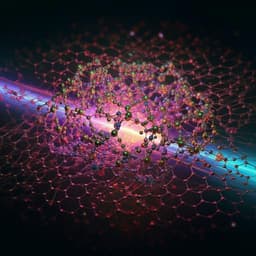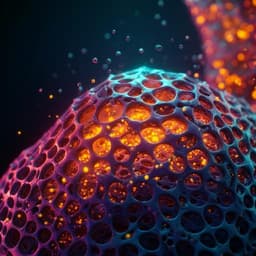
Chemistry
Crystalline Hydrogen Bonding of Water Molecules Confined in a Metal-Organic Framework
J. Bae, S. H. Park, et al.
This groundbreaking study by Jinhee Bae, Sun Ho Park, Dohyun Moon, and Nak Cheon Jeong reveals the fascinating crystalline behavior of hydrogen-bonded water molecules within the nanocages of the HKUST-1 framework. The research uncovers unexpected spatial ordering at room temperature and highlights the dynamic nature of coordination bonds, challenging traditional assumptions about molecular behavior.
~3 min • Beginner • English
Introduction
Hydrogen bonds underpin key phenomena across chemistry, biology, physics, energy, and environmental science, yet the dynamics of water H-bonds under nanoscale confinement remain challenging to elucidate because confined water behaves differently from bulk. Zeolites and carbon nanotubes have been used to study confined water, but the chemical environment strongly modulates H-bond networks. Metal–organic frameworks (MOFs), with tunable porosity, topology, and chemistry, offer a platform to explore confined H-bond dynamics particularly relevant to proton conduction, adsorption heat pumps, and atmospheric water harvesting. In MOFs, pore size/shape, surface chemistry, and open metal sites (OMSs) influence water organization; OMSs can template H-bond networks by binding water and polarizing nearby molecules. This work investigates HKUST-1 (Cu3(BTC)2), a paddlewheel MOF whose OMSs face large cages, enabling strong interactions between coordinated and pore-filling water. The central hypothesis is that H-bonding between pore water and metal-coordinated water produces a measurable vibrational chain connectivity that alters the Cu–Cu paddlewheel stretch, and that pore-filling water exhibits ice-like spatial ordering at room temperature—indicative of crystalline H-bond behavior. The study also probes whether the confined H-bond exhibits a dynamic coordination-bond character at the Cu2+ centers and whether water coordination distorts the paddlewheel node.
Literature Review
Prior studies on confined water in zeolites and carbon nanotubes have revealed altered H-bond structures and transport (e.g., templated chains, pressure/field effects) but with system-dependent behavior (refs. 17–23). In MOFs, emerging work shows OMS-templated water structures and loading-dependent framework responses: Paesani, Dincă and co-workers observed disconnected 1D H-bond chains templated by Co OMSs as humidity increased (ref. 37). Walton and co-workers visualized loading-dependent water positions in a Zn-based paddlewheel MOF, with unbound water near hydrophilic surfaces at low loading and in pore centers at high loading (ref. 38). Water structures in MOFs relevant to atmospheric water harvesting evolve with humidity and topology (ref. 39). HKUST-1 specifically exhibits a Cu–Cu stretching mode in Raman that is sensitive to the coordinated ligand (e.g., water, MeOH, EtOH), suggesting a probe for local environment and potential second-sphere effects from H-bonded guests (refs. 40–44). These studies motivate exploring how H-bond networks around OMSs couple to metal–metal vibrations and induce ordering in confined water.
Methodology
- Materials and synthesis: Large single crystals of HKUST-1 (Cu3(BTC)2) were synthesized following established procedures. Pristine crystals were washed and thermally activated under vacuum (150 °C, ~10−3 Torr, 24 h) to remove coordinating and pore-filling guests (Act-HKUST-1).
- Sample sets: (i) Act-HKUST-1 (no water), (ii) H2O[C]-HKUST-1 (primarily coordinated water at OMSs) prepared by controlled exposure to humid air until the Cu–Cu Raman band shifted from 231 to ~165 cm−1, (iii) H2O[F]-HKUST-1 (coordinated plus pore-filling water) prepared by vial-in-vial exposure to water vapor, (iv) MeOH[F]- and EtOH[F]-HKUST-1 prepared by soaking Act-HKUST-1 in purified MeOH or EtOH. Phase purity and guest content were checked by 1H NMR (after digestion) and PXRD.
- Raman spectroscopy: Ex situ Raman at 220 K and 298 K tracked the Cu–Cu stretching band upon progressive guest removal from filled samples under vacuum, and temperature dependence at 170, 220, 250, and 298 K. Isotope tests introduced D2O and H2 18O. In situ Raman at room temperature monitored time-resolved spectral evolution during water ingress into Act-HKUST-1.
- SCXRD: Synchrotron single-crystal X-ray diffraction was performed ex situ at 220 K on Act-HKUST-1, H2O[C]-HKUST-1, and H2O[F]-HKUST-1 to determine positions/occupancies of coordinated and pore-filling water and Cu–Cu distances. In situ SCXRD at 298 K monitored structural evolution (Cu–Cu length, guest occupancies, pore site preferences) during stepwise exposure of an oil-coated Act-HKUST-1 crystal to humid air (data collected at 5–30 min intervals).
- Water uptake and optical/UV–vis: Microbalance measurements recorded mass gain of Act-HKUST-1 during exposure to ambient air (RH ~30%) to determine [H2O]/[Cu2+] stoichiometry and infer average number of H-bonds per coordinated water. Optical microscopy documented color changes; diffuse reflectance UV–vis probed d–d transitions of Cu2+ during hydration.
- Instrumentation details: Raman (532 nm, 0.05 mW, ×10 objective), PXRD (Cu Kα), UV–vis (solid-state diffuse reflectance), microbalance, optical microscopy, and synchrotron SCXRD at PAL. Detailed sample handling ensured moisture control (glove box, sealed quartz cells, Parabar oil for SCXRD).
Key Findings
- Vibrational chain connectivity: The Cu–Cu stretching Raman band reports the sequential coupling Cu–Cu…H2O(coordinated)…H2O(H-bonded).
• Act-HKUST-1: Cu–Cu band at 231 cm−1.
• H2O[C]-HKUST-1: 166 cm−1 (lowest frequency, indicating weakened Cu–Cu due to coordination).
• H2O[F]-HKUST-1: 176 cm−1 (blueshift from 166 cm−1 due to H-bonded water weakening the coordination through chain connectivity).
• During water egress at 298 K, the Cu–Cu band shifts from 176 → ~163 cm−1 as pore water is removed, then to 231 cm−1 after full removal of coordinated water; temperature (170–298 K) and isotope (D2O, H2 18O) have negligible effect on the Cu–Cu band position, confirming the chain connectivity is not temperature- or isotope-dependent. O–H stretching (3110–3146 cm−1) redshifts and sharpens upon cooling due to stronger ice-like H-bonds.
- Generality to alcohols: EtOH[F]- and MeOH[F]-HKUST-1 show Cu–Cu bands at 188 and 180 cm−1, respectively; these redshift to 178 and 172 cm−1 upon removal of pore-filling molecules and return to 231 cm−1 after removing coordinating guests, indicating analogous chain connectivity and enhanced H-bonding strength under confinement.
- SCXRD at 220 K (ex situ):
• Act-HKUST-1 contains no water.
• H2O[C]-HKUST-1 unexpectedly includes both coordinated H2O and ~40 mol% type-1 pore-filling H2O (H2O[F]1) near OMSs in type-I cages, evidencing a strong preference for H-bonding sites adjacent to coordinated water.
• H2O[F]-HKUST-1 contains coordinated H2O[C] and two pore-filling types (H2O[F]1 and H2O[F]2) with O[C]–O[F] distances of 2.825 Å and 3.065 Å; Cu–O[C] = 2.199 Å. Cu–Cu distances depend on state: 2.485 Å (activated), 2.624 Å (coordinated), 2.613 Å (filled).
- In situ SCXRD at 298 K: Cu–Cu length increases from 2.484 Å (dry) to a maximum of 2.632 Å when H2O[C] and H2O[F]1 reach 100% and 34% occupancies, respectively, then decreases to 2.617 Å at longer exposure (240 min) as additional pore-filling sites (H2O[F]2 and H2O[F]3) populate type-II cages. These structural changes correlate with Raman: 231 → 163 cm−1 (elongation 2.484 → 2.632 Å), then 163 → 176 cm−1 (shortening 2.632 → 2.617 Å).
- Water uptake and H-bond coordination number: Continuous mass gain of 52.7 wt% yields [H2O]/[Cu2+] ≈ 5.9; an inflection at ~8.3 wt% corresponds to [H2O[C]]/[Cu2+] ≈ 1.0, implying [H2O[F]]/[H2O[C]] ≈ 4.9 H-bonds around each coordinated water. This agrees with a theoretical maximum [H2O[F]]/[Cu2+] = 4.66 derived from fully filled structures.
- Spatial ordering: In situ and ex situ SCXRD at 298 K reveal that unbound pore-filling H2O occupies specific, ordered sites proximal to coordinated water in type-I cages, demonstrating ice-like ordering at room temperature.
- Paddlewheel distortion: As Cu–Cu length increases, the OBTC–Cu–OBTC angle decreases; concurrently, Cu–O[C] distances decrease, consistent with electron donation from the coordinated H2O to antibonding orbitals (b1(x2–y2) or a1(z2)). After extensive H-bond formation (later hydration stages), clear trends in these parameters become less apparent, likely due to smaller subsequent changes in Cu–Cu length.
Discussion
The results directly address the hypotheses that confined water H-bonds can exhibit crystalline behavior and couple vibrationally to the metal–metal bond. Raman spectroscopy reveals discrete, state-specific Cu–Cu band positions associated with dry, coordinated, and H-bond-influenced states, proving chain connectivity between Cu–Cu stretching and H-bond networks mediated by coordinated water. SCXRD corroborates these spectroscopic signatures by quantifying Cu–Cu elongation upon coordination and partial reversal upon formation of H-bonds to pore-filling water, and by locating ordered pore water adjacent to OMS-bound water at room temperature. The continuous Raman blueshift toward 176 cm−1 during further hydration is consistent with an increasing number (~4.9 on average) of H-bonds around each coordinated water, supported by gravimetric uptake and theoretical limits from fully filled structures. The observed decrease in OBTC–Cu–OBTC angle with increasing Cu–Cu length, alongside shortening Cu–O[C], indicates a distortion driven by electron donation from coordinated water and modified by the surrounding H-bond network. Collectively, the coupling of structure and vibration demonstrates that H-bond networks in MOF nanopores can behave as elements of a crystalline lattice, with dynamic coordination-bond character enabling rapid ligand exchange at Cu2+ centers. These insights clarify how OMSs template H-bond networks and how confined water structures impact metal-node vibrations, informing the design of MOFs for proton conduction, adsorption heat pumps, and water harvesting.
Conclusion
This study demonstrates that water confined in HKUST-1 nanocages exhibits crystalline H-bond behavior characterized by: (i) vibrational chain connectivity linking the Cu–Cu paddlewheel stretch to coordinated and H-bonded water, (ii) ice-like spatial ordering of pore water at room temperature, and (iii) distortion of the paddlewheel node upon water coordination. Raman and synchrotron SCXRD reveal synchronized changes in Cu–Cu distance and vibrational frequency, while gravimetric and structural analyses indicate an average of ~4.9 H-bonds around each coordinated water and a maximum [H2O[F]]/[Cu2+] ≈ 4.66. The data support a dynamic coordination-bond character of the confined H-bond, wherein an H-bonded water can rapidly replace a coordinated water at the Cu2+ center. These findings advance the fundamental understanding of H-bond networks in confined environments and provide guidance for engineering MOFs with tailored water structures for applications such as proton conduction, adsorption-based heat pumping, and atmospheric water harvesting. Future work should further quantify how H-bond formation affects node geometry (OBTC–Cu–OBTC angle, Cu–O lengths) across broader hydration states and MOF chemistries.
Limitations
- After substantial H-bond formation in later hydration stages (H2O-HKUST-1(6th–9th)), clear patterns in changes of OBTC–Cu–OBTC angles and Cu–O[C] lengths were not observed, indicating the need for more detailed studies to resolve subtle geometric effects of H-bond networks.
- The dynamic coordination-bond character of the H-bond is inferred from correlated spectroscopic and crystallographic observations; direct time-resolved measurements of ligand exchange dynamics at the Cu2+ centers were not performed.
- Isolating states with exclusively coordinated water versus exclusively H-bonded pore water is inherently challenging; even the nominally coordinated-only sample contained ~40 mol% pore-filling water near OMSs at 220 K, reflecting the strong tendency of pore water to occupy adjacent sites.
Related Publications
Explore these studies to deepen your understanding of the subject.







